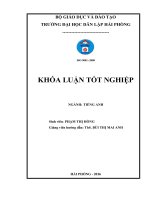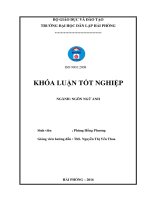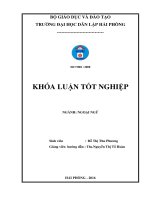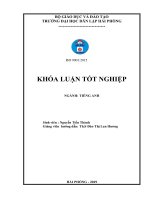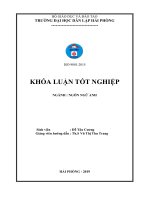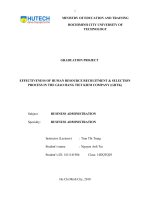16S metagenomics analysis of endometrial microbiota in vietnamese woman (khóa luận tốt nghiệp)
Bạn đang xem bản rút gọn của tài liệu. Xem và tải ngay bản đầy đủ của tài liệu tại đây (1.68 MB, 48 trang )
VIETNAM NATIONAL UNIVERSITY OF AGRICULTURE
FACULTY OF BIOTECHNOLOGY
*******
GRADUATION THESIS
“16S METAGENOMICS ANALYSIS OF
ENDOMETRIAL MICROBIOTA IN VIETNAMESE
WOMAN”
HA NOI, 2021
VIETNAM NATIONAL UNIVERSITY OF AGRICULTURE
FACULTY OF BIOTECHNOLOGY
*******
GRADUATION THESIS
“16S METAGENOMICS ANALYSIS OF
ENDOMETRIAL MICROBIOTA IN VIETNAMESE
WOMAN”
Student’s name
: Le Doan Quoc
ID
: 610760
Class
: K61CNSHE
Supervisor
: Dr. Pham Dinh Minh
Prof. Phan Huu Ton
HA NOI, 2021
STATEMENT OF ORIGINAL AUTHORSHIP
The work contained in this thesis has not been previously submitted to meet
requirements for an award at this or any other education institution. To the best of my
knowledge and belief, the thesis contains no material previously published or written by
another person except where due reference is made.
Signature:
Date:
2
ACKNOWLEDGEMENTS
This thesis, like any other, would not have been possible without the involvement and
support of many people. They have all earned my deepest gratitude, even if it has been
poorly expressed at times.
First and foremost, my sincere thank goes to my principal supervisors, Dr. Pham Dinh
Minh and Prof. Phan Huu Ton, for their ongoing support and suggestions through my
graduation thesis. Without them, this project would not have been possible.
I would like to thank to all Staff at Gentis Company who have had to put up with me
going through all kinds of emotional swings also deserve my thanks. They were all very
friendly and helpful to me, I was lucky to study in a great working environment.
Last, but not least, I thank my family and friends for all their help, encouragement
and for supporting me through all these years.
3
TABLE OF CONTENT
STATEMENT OF ORIGINAL AUTHORSHIP ................................................ i
ACKNOWLEDGEMENTS ............................................................................... 3
TABLE OF CONTENT ....................................................................................... i
LIST OF ABBREVIATIONS .......................... Error! Bookmark not defined.
LIST OF TABLES .............................................................................................. 7
LIST OF FIGURES .......................................... Error! Bookmark not defined.
PART ONE: INTRODUCTION........................................................................ 9
1.1. Introduction .................................................................................................... 9
1.2. Aims and requirements ................................................................................ 12
1.2.1 Aims ........................................................................................................... 12
1.2.2. Requirements ............................................................................................ 12
PART TWO: LITERATURE REVIEW ........................................................ 13
2.1. The importance of 16S metagenomics......................................................... 13
2.2. Choosing the Appropriate Target Region .... Error! Bookmark not defined.
2.3. Taxonomic Classification: The Growing of 16S rRNA Databanks ..... Error!
Bookmark not defined.
2.4. Bioinformatics pipelines for micrbial 16S rRNA amplicon sequencingError!
Bookmark not defined.
2.5. Human Endometrial Microbiota .................. Error! Bookmark not defined.
2.5.1.Relevant researches over the world ........... Error! Bookmark not defined.
2.5.2.Asia ............................................................ Error! Bookmark not defined.
2.5.3. ASEAN.............................................................................. Error! Bookmark not defined.
2.5.4. Vietnam ..................................................... Error! Bookmark not defined.
PART THREE: MATERIALS AND METHODS ......................................... 27
4
3.1. Location and duration of the study .............................................................. 27
3.2. Materials....................................................................................................... 27
3.2.1. DNA Extraction ........................................ Error! Bookmark not defined.
3.2.1.1. Samples .................................................. Error! Bookmark not defined.
3.2.1.2. DNA Purification from Body Fluids ..... Error! Bookmark not defined.
3.2.2. Amplication V3-V4 region on 16S micrbial genesError!
Bookmark
not
defined.
3.2.3. Library Preparation ................................... Error! Bookmark not defined.
3.2.3.1. PCR Clean-up ........................................ Error! Bookmark not defined.
3.2.3.2. Index PCR .............................................. Error! Bookmark not defined.
3.2.3.3. PCR Clearn-up 2 .................................... Error! Bookmark not defined.
3.2.3.4. Library quantification, Normalization, and PoolingError! Bookmark not
defined.
3.3. Methods ........................................................ Error! Bookmark not defined.
3.3.1. Data analysis ............................................. Error! Bookmark not defined.
3.3.1.1. Amplicon bioinformatics: from raw reads to tablesError! Bookmark not
defined.
3.3.1.2. Filter and trim......................................... Error! Bookmark not defined.
3.3.1.3. Learn the Error Rates ............................. Error! Bookmark not defined.
3.3.1.4. Merge paired reads ................................. Error! Bookmark not defined.
3.3.1.5. Construct sequence table........................ Error! Bookmark not defined.
3.3.1.6. Remove chimeras ................................... Error! Bookmark not defined.
3.3.1.7. Assign taxonomy ................................... Error! Bookmark not defined.
PART IV. RESULTS AND DISCUSSION ..................................................... 36
4.1.Bioinformatics pipeline ................................. Error! Bookmark not defined.
4.1.1.Quality score of sequences......................... Error! Bookmark not defined.
5
4.1.2. Filter and Trim .......................................................... Error! Bookmark not defined.
4.1.3. Finding true sequence variants ................. Error! Bookmark not defined.
4.1.4. Merging Paired Reads ............................... Error! Bookmark not defined.
4.1.5. Contructing ASV table and removing chimerasError!
Bookmark
not
defined.
4.1.6. Assign taxonomy ...................................... Error! Bookmark not defined.
4.1.7. Visualizing alpha-diversity ....................... Error! Bookmark not defined.
4.1.8. Abundance bar plot ................................... Error! Bookmark not defined.
4.2. Discussion .................................................... Error! Bookmark not defined.
PART FIVE. REFERENCES .......................... Error! Bookmark not defined.
6
LIST OF ABBREVIATIONS
µL
microlitre
Bp
Base pair
CP
Common region
CR
Common region
DNA
Deoxyribonucleic acid
dNTP
Deoxynucleotide triphotphate
dsDNA
Double DNA
mL
milliliter
PCR
Polymerase Chain Reaction
RCA
Rolling circle amplification
RE
Restriction enzyme
REP
Replacation protein
rpm
revolutions per minute
NGS
Next Generation Sequencing
ssDNA
Singe strand DNA
TAE
Tris – acetate – EDTA
Taq
Thermus aquatic
7
ABSTRACT
Diagnosis of bacteria with NGS methods has facilitated the research of low
biomass microbiomes in tissues and organs previously considered sterile, for
instance, the endometrium. Therefore, an abnormal endometrial microbiota has been
proved to link with implantation failure, pregnancy loss, and other gynecological
and obstetrical conditions. Future investigation of the endometrial microbiota could
enhance a further insight of bacterial communities’ role in both physiology and
pathophysiology, with the hope that can aid the ability to increase of pregnancy rate
and create a healthy pregnancy. 16S rRNA gene sequencing, or simply 16S
sequencing, utilizes PCR to target and amplify portions of the hypervariable regions
(V1-V9) of the bacterial 16S rRNA gene1. In this project, sequences generated from
Illumina MiSeq was created with V3-V4 region. After sequencing, raw data is
analyzed with a bioinformatics pipeline which includes trimming, error correction,
and comparison to a 16S reference database. In this study, the method is applied for
a small sample of three Vietnamese Women with the hope that could lead to a little
contribution to the development of research relevant to endometrial microbiota as
well as study using 16S metagenomics pipeline.
8
PART ONE: INTRODUCTION
1.1.
Introduction
The main part of microbial cells that can be seen in microscope and shown to
be living with various staining procedures cannot be invoked to create colonies on
Petri plates. Actually, there was only 0.1 to 1 percentage of the living bacteria when
culture soils with standard conditions. Furthermore, when culture microbes in
aquatic environments the number of microbes could be thousand times lower.
Moderate and high throughput nutrients were put to help the existing problems. But
the result of cultivation of microbe in isolation continues to be low. The problem
could be harder because for most of the time these bacteria need community to grow.
Under laboratory cultivation conditions, this always favor the identification of
organisms that can live best with these special nutrients. This mean in turn not
appropriate for those microbes which are dominant or most influential in the native
environment of bacteria.
These limitations have given the rise of culture-independent methods for
identifying and enumerating microbes in the community. Over the decades these
gradually have played a bigger role in the isolation of bacteria. The technique has
been used widely is rRNA phylotyping, which is predominant among microbes. This
9
powerful technique is based on databases of rRNA gene sequences. These databases
nowadays are enriched overtime from researchers. By identify the rRNA genes of
organisms, these were compared to the branch to position. This could infer the
nearest branch to infer that organism could have similar biology and ecology with
the closest relavtives. The polymerase chain reaction makes rRNA genes to be
detected and copied directly from environmental samples, then cloned and
sequenced. If the environmental sample contains many types of organisms, there
will be many different rRNA sequences, the diversity of which will be a measure of
the complexity of the community.
With the development in metagenomics, not-yet-cultivated microbes in
biotechnology has been explored in terms of DNA-base investigation. Research
fields like ecology, community biology, and microbiome research has significantly
changed their views when metagenome term was coined 20 years ago. Furthermore,
it has led to several important identification of biomolecules that have a huge
potential application to bio-based industrial processes. Laboratories over the world
has been investigate the novel functional genes which called function-driven
metagenomics. In another way, this creates more helpful applications relevant to the
diversity of biocatalysts and valuable biomolecules.
Metagenomics infer to both a research technique and research field.
Metagenomics, the field can be defined as the genomic analysis of microbial DNA
from microbial environment. Metagenomics tools allows the diversity analysis of
independent-culturable or previously unknown microbes. This is important as only
around 1-2% of bacteria can be cultured in the laboratory. The ability to identify
10
microbes without a priori knowledge of what a sample contains is opening new doors
in disciplines like microbial ecology, virology, microbiology, environmental
sciences and biomedical research. Sequencing based examination of the
metagenome has become a powerful tool for generating novel hypotheses.
The 16S rRNA gene is a taxonomic genomic marker that is common to almost
all bacteria and archaea. The marker allows one to examine genetic diversity in
microbial communities, specifically what microbes are present in a sample. While
some estimates of relative abundance within similar samples can be made, drawing
conclusions across different sample types is not recommended due to amplification
artifacts introduced during PCR.
16S rRNA sequencing is accomplished by designing primers to the entire 16S
locus or targeting multiple hypervariable domains within the gene. The nine variable
regions of the 16s rRNA gene are flanked by conserved stretches in the majority of
bacteria. Conserved regions can be used as targets for PCR primers, designed
upstream and downstream of the variable domains. These hypervariable regions
provide the species-species signature necessary for identification. After these
domains have been amplified, sequencing related primers are either ligated or added
by a second PCR step.
11
1.2. Aims and requirements
1.2.1 Aims
The major aim of the project is to create 16S metagenomics bioinformatics
for endometrial microbiota analysis in which the result includes the compositions of
microbiota in biopsies of endometrium. Most of the steps in wet lab were done by
high skilled staff. The bioinformatics pipeline in this project could lead to more
findings for similar experiment.
1.2.2. Requirements
1.
To extract DNA from endometrial biopsies for PCR and further analysis.
This step requires proper kit to retain a necessary amount of DNA.
2. Using primers to amplify the target gene, 16S, to make copies of V3-V4
region of 16S gene.
3. Cleaning the PCR products from previous step to eliminate or reduce
contamination.
4. Sequencing DNA sample by NGS technology, ILLUMINA sequencing
technology was applied in this project. In fact, MISEQ device was used.
5. Analyzing the sequences from sequencer to investigate composition of
microbiota in the sample by using modern pipeline bioinformatics DADA2.
12
PART TWO: LITERATURE REVIEW
2.1. The importance of 16S metagenomics
The ribosome plays a key role in the work of fundamental cellular processes
since it a part of interpreting the genetic code delivered by mRNA and construct the
chain of amino acids with the resembling of transfer RNA, which eventually folds
into fully functional proteins, this is extremely complex process called translation.
Every living thing all has a similar machinery at a basic that mean from an
evolutionary perspective, the whole process is extremely conserved. In fact,
ribosome is built up from only dozens of distinct proteins plus a few distinct RNA
molecules, which are called ribosomal RNA (rRNA). Prokaryotic ribosomes account
for 65% rRNA and 35% ribosomal proteins. The whole structure of the ribosome is
composed of two multimeric subunits, which are the large subunit (50S), which
contains two rRNA molecules (5S and 23S), and the small subunit (30S), which
contains a single rRNA molecule (16S). There are scientific reasons that make 16S
rRNA an almost perfect candidate for the study of prokaryotic phylogenesis, a socalled molecular clock. In fact, three following features make 16S rRNA so nicely
fitting. First, 16S rRNA is the basic present part in all microbes. And the second, the
reason is with low probability of lateral gene transfer. Finally, the extremely
conserved scaffolding by ribosomal proteins makes its sequence extremely
conserved in certain regions, while other regions not directly involved in the
stabilization and exposed to solvent are relatively free from evolutionary constraints,
so they were extremely variable. In total, we can count nine variable regions (V1 to
13
V9) of different size in the approximately 1500 bp constituting a full 16S rRNA
molecule13.
(A) Two opposite sides of the 3D structure of the prokaryotic ribosome with ribosomal proteins,
23S rRNA, 16S rRNA and 5S rRNA in white, green, red and blue, respectively.
(B) Two opposite sides of the 3D structure of the prokaryotic ribosome small subunit (SSU)
with ribosomal proteins and 16S rRNA in white and red, respectively.
(C) Localization and color coding of the nine 16S variable regions in the 3D structure of a
14
scaffolded 16S rRNA devoid of ribosomal proteins.
(D) Localization of the nine, color-coded as in C, 16S variable regions in the classical twodimensional representation of the 16S rRNA secondary structure from E. coli.
2.2 Choosing the Appropriate Target Region
A vast majority of studies focused at the comparison of the bacterial
phylogeny with full-length 16S and shorter fragments were taking place in the recent
past, finding for an optimalization between read length and information content.
From these researches, some scientist believed he wisest rule is therefore to reuse as
much as possible the protocols already used by other groups for the same biome, that
could result to maximize the interpretation of the result and 16S rRNA-Based
taxonomy profiling. In several researches, many previously developed primers pairs
can be used to target the nine variable regions, both alone or in combination. It can
be observed that all regions can be extensively investigated using published primers,
although the biases associated with each primer in the pair are quite difficult to be
extracted from the literature. In the below figure, each bar represents the count of
primer pairs available for targeting the 16S rRNA gene regions indicated in the left
axis with the notation A–B, i.e., from region A to region B.
15
A survey of experimentally validated primer pairs. Each bar represents the count
of primer pairs available for targeting the 16S rRNA gene regions indicated in
the left axis with the notation A–B, i.e., from region A to region B. Data were
elaborated from the ProbeBase database.
16
Un-culture method of microbial identification is process by the utilization
of16S databanks, in which all these repositories maintain huge collections of 16S
rRNA sequences with an sufficient taxonomic assignment and that they can be
computationally accessed with the sequences of a primer pair in order to evaluate
whether some taxonomic rank is expected to be missing. The growth in size and
accuracy of data banks makes this process more and more reliable, especially for the
de novo design or verification of taxon-specific primers or probes. The recent
Illumina MiSeq platform which was used in this project has made a high-quality
300bp read extremely cost effective. On MiSeq platform, V3-V4 region is the
specialized protocol for 16S metagenomics which generate high coverage of genes
and high resolution for taxonomy.
2.3 Taxonomic Classification: The Growing of 16S rRNA Databanks
The Ribosomal Database Project (RDP) was published in 1992 and contained
447 entries of full length 16S sequences. At the moment, release 11.04 accumulates
3,224,600 aligned and annotated 16S rRNA framed in a revised taxonomic tree
enabled by the most recent updates from metagenomics and single-cell studies. At
every new release, all sequences are checked for chimerism and other sequencing
ambiguities, then fully (re-)classified by a naive Bayesian method called RDP
classifier. At every update, sequences from this tree are used to retrain the classifier,
so that it can easily classify 16S rRNA reads acquired from metagenomics
approaches.
The current release 18 includes a collection of 20,712 bacterial and 601 archaeal 16S
rRNA gene sequences . To consult this bank, query sequences are first framed in the
17
global alignment using a pairwise alignment with a candidate target (identified via a
k-mer search), then a 7-mer based statistic is used to identify a pool of nearneighbors whose taxonomy is imposed to the query sequence, provided a reasonable
edit distance is observed. SILVA is currently at release 138.1 and is the official
database of the software package ARB], a long-term project aimed at providing a
tool for handling, analyzing and visualizing sequences and related information. In
this project SILVA databank was used as the recommended database for DADA2
bioinformatic pipeline. Most pipelines, which propose an all-in-one solution for
analyzing 16S rRNA sequences, provide their own tools for taxonomic
classification, usually designed to cope with existing databases. Although sequences
are obtained from Illumina MiSeq with the ready software called MiSeq Reporter
but the software have limitation for further investigation on the microbial gene so
open computing pipeline is the reasonable resolution for researchers.
2.4 Bioinformatic pipelines for microbial 16S rRNA amplicon sequencing
There is a detailed research on bioinformatic pipelines for the analysis of
amplicon sequence data which are from 16S rRNA:
OTU-level
ASV-level
DADA2
DADA2
MOTHUR
Qiime2-Deblur
USEARCH-UPARSE
USEARCH-UNOISE3
DADA2 offered the best sensitivity, at the expense of decreased specificity
compared to USEARCH-UNOISE3 and Qiime2-Deblur9.
18
DADA2 (Divisive Amplicon Denoising Algorithm 2) uses a parametric model to
infer true biological sequences from reads. The model relies on input read
abundances (true reads are likely to be more abundant) and distances (less abundant
reads only a few base-differences away from a more abundant sequence are likely
error-derived). Base Q-scores are used to calculate a substitution model, estimating
a probability for each possible base substitution (e.g. A replacing G, G replacing T,
etc). Based on this substitution model and on the input reads abundances and
reciprocal distances, DADA2 uses a probability threshold to decide whether to
assign counts from a less abundant, “error-derived” read to a more abundant, “true”
sequence. DADA2 was run as an R script (in R v.3.4) using its R package (dada2
v.1.7).
In DADA2, reads are quality-filtered using the “filterAndTrim” function. Error rates
are subsequently learned from a set of subsampled reads (i.e., 1 million random
reads). Error rates are estimated separately for each sequencing run, since different
runs may have different error profiles. Reads are then deduplicated and ASVs are
inferred. Uniquely, DADA2 retains a summary of the quality scores associated with
each unique sequence (the average of the positional qualities from deduplicated
reads). These quality scores are subsequently used to perform ASV inference. Also,
unlike all the other pipelines, DADA2 denoises the forward and the reverse reads
independently. ASVs from the forward and reverse flows are only merged at the end
of
the
workflow
prior
to
the
removal
of
chimeric
ASVs,
using
“removeChimeraDenovo”. Removing or truncating reads with ambiguous bases is
mandatory in DADA2.
19
2.5 Human Endometrial Microbiota
For a long time, some scientists believed that an infant develops in a sterile
womb and its first contact with the bacteria occurs during entering the birth canal.
Recent studies on this subject has shown that meconium is not sterile, and bacteria
were also detected in amniotic fluid, umbilical cord and fetal membranes of healthy
term babies. The barrier between vagina, uterus and the fallopian tubes, the cervix,
were supposed to be sterile as well. Nonetheless, some studies have proven to
conclude that the uterine cavity is contaminated with microorganisms in a significant
number of patients who show the symptoms of hysterectomies. It has been
recommended to send the endometrium biopsy samples for histological and
microbiological testing prior to the hysterectomy. The result of this and many other
studies have shown, that there is a microbiota continuum along the female
reproductive tract.
20
NGS has allowed a vast evaluation of bacterial composition of the uterus over
the globe as it cannot be measured with culture dependent methods. Genomic DNA
isolated from a sample contains random fragments of bacterial genomes and also can
be, with the probability, contaminated by host DNA or DNA of other organisms
present in this sample. 16S RNA amplicon sequencing can be targeted specifically
against bacteria. It also does not require the availability of whole reference genome
sequences. In addition, it can be applied in cases where only a small amount or poorquality bacterial DNA templates are accessible. With that being said, 16S rRNA
sequencing became a standard method in bacterial community profiling. The role of
immune system in uterus colonization cannot be forgotten. Studies have shown that
the endometrial fluid and the uterine mucosal surface contain infection-controlling
molecules, known as antimicrobial peptides (AMPs), with changing levels during
the menstrual cycle. AMPs are contributing to female reproductive tract health with
implication for fertility and pregnancy.
There are some indications that uterine microbiome might influence
endometrial receptivity. Early prospective studies considering the role of
endometrial microbial colonization suggested that positive microbiological
endometrial culture, obtained from the tip of the transfer catheter in patients
undergoing in vitro fertilization, had negative effects on implantation and pregnancy
rates. Genus Lactobacillus is a very important component in major part of the uterine
microbiome studies. There is a evidence that high levels of Lactobacillus (over 90%
as defined by the group) are significantly associated with growing reproductive
success in women undergoing IVF. Nevertheless, it has not been determined, which
species of Lactobacillus may be capable of conferring this benefit.
21
2.5.1 Relevant researches over the world
The endometrium is a challenging site for metagenomic analysis due to difficulties
in obtaining uncontaminated samples and the limited abundance of the bacterial
population. Indeed, solid correlations between endometrial physio-pathologic
conditions and bacteria compositions have not yet been firmly established.
The first large-scale metagenomic investigations on human microbiota focused on
body sites directly exposed to external sources of colonization (skin, mouth, vagina,
gut, etc.) in the course of the Human Microbiome Project (HMP) (The Human
Microbiome Project Consortium, 2012). Nevertheless, even sites not directly
exposed to external environments can harbor specific microbiotas that in turn
influence the host physio-pathologic conditions. The uterus is one of these sites.
Nowadays, evidence from NGS investigations strongly supports the existence of a
uterine microbiota and metagenomic approaches are gaining momentum in the
analyses of the human endometrial microbiota under different conditions. Several
reviews and commentary articles are already available on this specific topic. Besides
advances in the knowledge of the microbiota composition and its origin, these
studies can also help to establish possible correlations between microbiota
composition and uterus specific physiologic or pathologic conditions, including
pregnancy, sterility, and conditions in which assisted reproductive technologies
(ART) are adopted.
22
Ref
Moreno et al.
(2016)
Aim
Investigati
on of the
presence
of a
uterine
microbio
me
Hormonal
regulation
of
microbio
me
WaltherAntonio et al.
(2016)
Miles et
al.(2017)
Impact on
reproducti
ve
outcome
Compositi
on of the
uterine
microbio
me, its
role in
endometri
al cancer
Subj
ects
(no.
Of
wo
men
)
13
Fertile
22
Fertile
35
Infertile,
undergoing
IVF, receptive
endometrium
10
Benign uterine
conditions
(pelvic pain,
abnormal
bleeding,
fibroids,
prolapse)
Endometrial
hyperplasia
(cancer
precursor)
Endometrial
cancer
Undergoing
hysterectomy
and bilateral
salpingooopherectomy
4
17
Investigati 10
on of
microbiota
compositi
on within
female
reproducti
ve tract of
women
undergoin
Cohort
specification
(Inclusion
criteria)
Sequenci
ng
platform
Varia
ble
regio
ns
Consistently found species
454
pyrosequenci
ng on
454 Lif
Sciences
GS FLX
+
instrume
nt
(Roche)
V3V5
71.7% Lactobacillus,
12.6% Gardnerella,
3.7% Bifidobacterium,
3.2% Strptococcus,
0.9% Prevotella; if
samples non-Lactobacillus
dominated Atopodium,
Clostridium, Gardnerella,
Megasphaera, Parvimonas,
Prevotella, Sphingomonas
or Sneathia genera
abundant
MiSeq
(Illumina
)
V3V5
Shigella, Bamesiella,
Staphylococcus, Blautia,
Parabacteroides
454
pyrosequenci
ng on
Life
Sciences
instrume
nt
(Roche)
V1V3
Lactobacillus,
Acinetobacter, Blautia,
Corynebacterium
Staphulococcus
23
Tao et al.
(2017)
Chen et al.
(2017)
g
hysterecto
my/
bilateral
salpingooopherect
omy (pilo)
Investigati 70
on of
endometri
al
microbial
colonizati
on at the
time of
embryo
transfer
during
IVF using
ultra-low
bacteria
counts
Investigati 80
on of
microbiota
compositi
on within
female
reproducti
ve tract
Estimation
of
bacterial
15
biomass
of female
reproducti
ve tract
Undergoing
IVF
MiSeq
(Illumina
)
V4
Lactobacillus spp 33
samples contained over
90% of Lactobacillus
abundance, 50 samples
over 70%
Corynebacterium (40
patients), Staphylococcus
(38 patients)
Streptococcus (38
patients), Bifidobacterium
(15 patients)
Surgery for
conditions not
known to
involve infect
on
(hysteromyom
a,
adenomyosis,
endometriosis,
salpingemphra
xis)
Ion
PGMTM
system
sequenci
ng
(Thermo
Fisher)
V4V5
Lactobacillus (30.6%),
Pseudomonas (9.1%),
Acinetobacter(9.1%),
Vagococcus (7.3%) and
Sphingobium (5%)
Validation
if
sequencin
g live
bacteria or
debris
Studies presenting uterine microbiome assessment based on 16S rRNA5.
24


